Flutter 小技巧之 Shader 实现酷炫的粒子动画
在之前的《不一样的思路实现炫酷 3D 翻页折叠动画》我们其实介绍过:如何使用 Shader 去实现一个 3D 的翻页效果,具体就是使用 Flutter 在 3.7 开始提供 Fragment Shader API ,因为每个像素都会过 Fragment Shader ,所以我们可以通过写一个 Fragment Shader 的 glsl 文件来处理图片的像素效果,例如下图这样的粒子化效果:
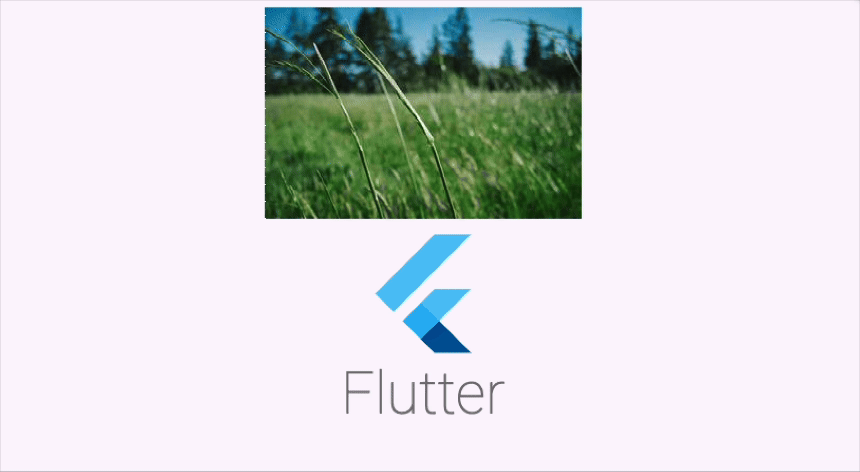
这个效果来自于 thanos_snap_effect ,它巧妙地采用了多种组合方式实现了 UI 的粒子化效果:
- 对当前控件进行截图
- 通过
OverlayPortal生成一个局部图层 - 使用 shader 在局部图层对截图进行粒子画动画
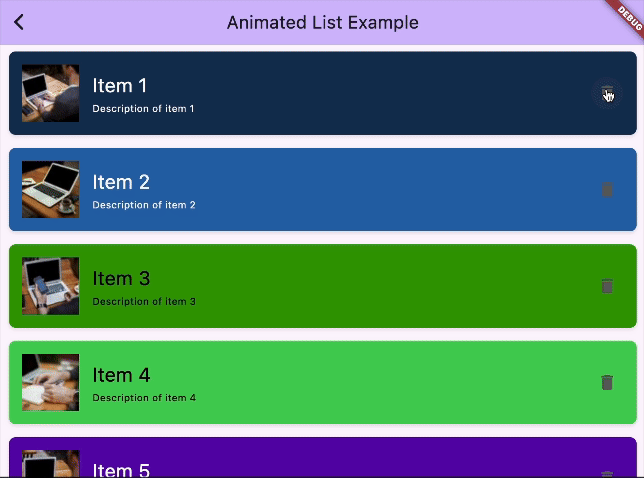
截图和 OverlayPortal 都是 Flutter 在 Dart 层面的 API 支持,而粒子化效果就确确实实需要用到 Shader 代码的实现,至于为什么需要用到 Shader,理由还是之前发过的性能对比:
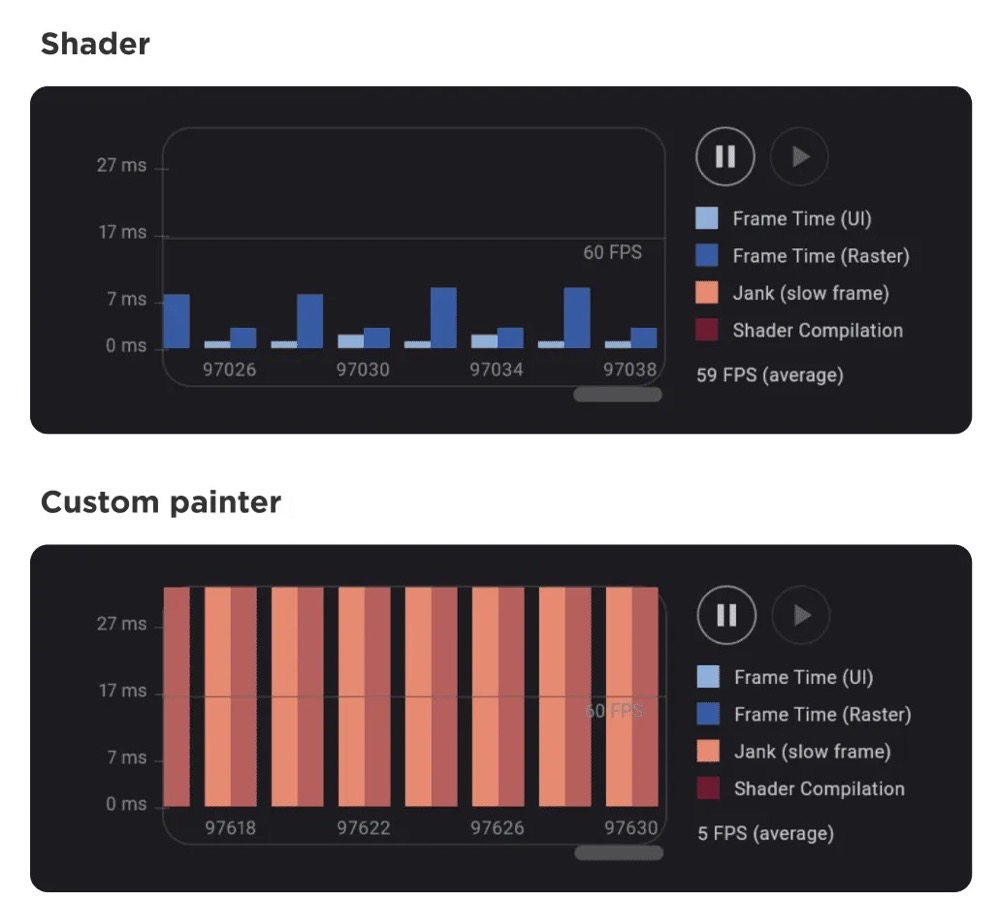
另外 Flutter 默认对图片的 API 支持能力本来就比较弱
简单来说,Flutter 里加载和启用一个 Shader ,只需要:
- 通过
ui.FragmentProgram.fromAsset加载 glsl 文件 - 给 Shader 设置参数,参数是通过定义的顺序(0、1、2····)去设置,另外还可以通过同样方式,通过
setImageSampler设置图片 - 通过 canvas 绘制 Shader
final ui.FragmentProgram program = _shaderCache[widget.shaderAsset] ??await ui.FragmentProgram.fromAsset(widget.shaderAsset);final shader = program.fragmentShader();·····shader.setFloat(0, size.width);shader.setFloat(1, size.height);shader.setFloat(2, currentTime.inMilliseconds.toDouble() / 1000.0);shader.setImageSampler(0, snapshotInfo.image);final Paint paint = Paint()..shader = shader;canvas.drawRect(Offset.zero & size, paint);
参数的对应是按照顺序来决定,大概理解就是,vec2 就是两个 float 类型的值保存在了一起的意思,所以先声明的 vec2 resolution 就占据了索引 0 和 1 ,如下图所示,此时的 vec2 和 vec3 分了就占据了 0-1 和 2-4 的索引:
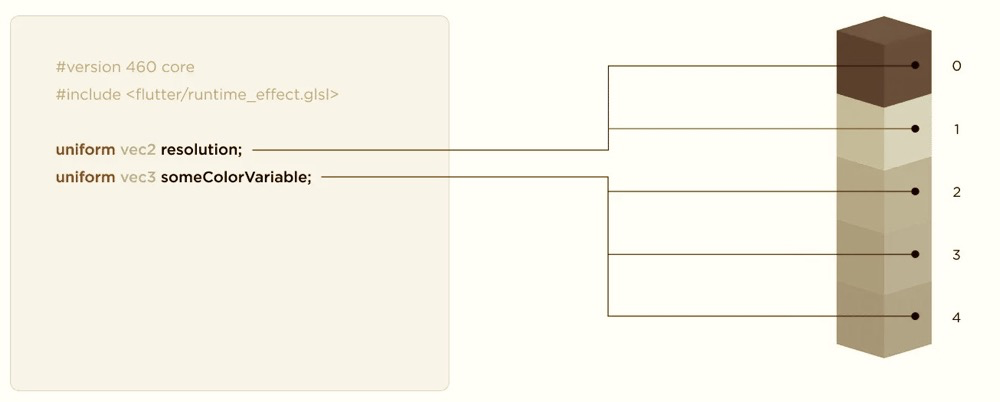
详细 Flutter Shader 基础教程,可见之前的 《Flutter 小技巧之不一样的思路实现炫酷 3D 翻页折叠动画》 或者张风捷特烈大佬的Flutter & GLSL系列: https://juejin.cn/post/7295948894328029193
接下来我们主要看粒子动画的完整代码,可以看到抛开注释之外,其实代码并不复杂,这也是因为对于 Fragment Shader 而言,每个像素都需要经过这段代码处理,所以在处理像素效果上天然就要比在 Dart 利索:
#version 460 core#include<flutter/runtime_effect.glsl>#define min_movement_angle -2.2#define max_movement_angle -0.76#define movement_angles_count 10#define movement_angle_step (max_movement_angle - min_movement_angle) / movement_angles_count#define pi 3.14159265359// Current animation value, from 0.0 to 1.0.uniform float animationValue;uniform float particleLifetime;uniform float fadeOutDuration;uniform float particlesInRow;uniform float particlesInColumn;uniform float particleSpeed;uniform vec2 uSize;uniform sampler2D uImageTexture;out vec4 fragColor;float delayFromParticleCenterPos(float x){return (1. - particleLifetime)*x;}float delayFromColumnIndex(int i){return (1. - particleLifetime) * (i / (particlesInRow));}float randomAngle(int i){float randomValue = fract(sin(float(i) * 12.9898 + 78.233) * 43758.5453);return min_movement_angle + floor(randomValue * movement_angles_count) * movement_angle_step;}int calculateInitialParticleIndex(vec2 point, float angle, float animationValue, float particleWidth, float particleHeight){// x0 value is calculated from the following equation:// Given:// x = x0 + t * cos(angle) * particle_speed// t = animationValue - delay// delay = (1 - particle_lifetime) * x0// Getting the x0 from the equation:// t = animationValue - (1 - particle_lifetime) * x0// x = x0 + (animationValue - (1 - particle_lifetime) * x0) * cos(angle) * particle_speed// x = x0 + animationValue * cos(angle) * particle_speed - (1 - particle_lifetime) * x0 * cos(angle) * particle_speed// x = x0 - (1 - particle_lifetime) * x0 * cos(angle) * particle_speed + animationValue * cos(angle) * particle_speed// x = x0 * (1 - (1 - particle_lifetime) * cos(angle) * particle_speed) + animationValue * cos(angle) * particle_speed// x - animationValue * cos(angle) * particle_speed = x0 * (1 - (1 - particle_lifetime) * cos(angle) * particle_speed)// x0 = (x - animationValue * cos(angle) * particle_speed) / (1 - (1 - particle_lifetime) * cos(angle) * particle_speed)float x0 = (point.x - animationValue * cos(angle) * particleSpeed) / (1. - (1. - particleLifetime) * cos(angle) * particleSpeed);float delay = delayFromParticleCenterPos(x0);float y0 = point.y - (animationValue - delay) * sin(angle) * particleSpeed;// If particle is not yet moved, animationValue is less than delay, and particle moves to an opposite direction so we should calculate a particle index from the original point.// If the particle is supposed to move to the left, but it moves to the right (because of the reason above), return the original point particle index.if (angle <= - pi / 2 && point.x >= x0){return (int(point.x / particleWidth) + int(point.y / particleHeight) * int(1 / particleWidth));}// If the particle is supposed to move to the right, but it moves to the left (because of the reason above), return the original point particle index.if (angle >= - pi / 2 && point.x < x0){return (int(point.x / particleWidth) + int(point.y / particleHeight) * int(1 / particleWidth));}return int(x0 / particleWidth) + int(y0 / particleHeight) * int(1 / particleWidth);}void main(){vec2 uv=FlutterFragCoord().xy / uSize.xy;float particleWidth = 1.0 / particlesInRow;float particleHeight = 1.0 / particlesInColumn;float particlesCount = (1 / particleWidth) * (1 / particleHeight);for (float searchMovementAngle = min_movement_angle; searchMovementAngle <= max_movement_angle; searchMovementAngle += movement_angle_step){int i = calculateInitialParticleIndex(uv, searchMovementAngle, animationValue, particleWidth, particleHeight);if (i < 0 || i >= particlesCount){continue;}float angle = randomAngle(i);vec2 particleCenterPos = vec2(mod(float(i), 1 / particleWidth) * particleWidth + particleWidth / 2, int(float(i) / (1 / particleWidth)) * particleHeight + particleHeight / 2);float delay = delayFromParticleCenterPos(particleCenterPos.x);float adjustedTime = max(0.0, animationValue - delay);vec2 zeroPointPixelPos = vec2(uv.x - adjustedTime * cos(angle) * particleSpeed, uv.y - adjustedTime * sin(angle) * particleSpeed);if (zeroPointPixelPos.x >= particleCenterPos.x - particleWidth / 2 && zeroPointPixelPos.x <= particleCenterPos.x + particleWidth / 2 &&zeroPointPixelPos.y >= particleCenterPos.y - particleHeight / 2 && zeroPointPixelPos.y <= particleCenterPos.y + particleHeight / 2){vec4 zeroPointPixelColor = texture(uImageTexture, zeroPointPixelPos);float alpha = zeroPointPixelColor.a;float fadeOutLivetime = max(0.0, adjustedTime - (particleLifetime - fadeOutDuration));fragColor = zeroPointPixelColor * (1.0 - fadeOutLivetime / fadeOutDuration);return;}}fragColor = vec4(0.0, 0.0, 0.0, 0.0);}
这里简单介绍这段代码的一些实现逻辑,首先就是角度,这部分代码直接定义了粒子移动的方向范围,可以移动的角度在 -2.2 ~ -0.76 之间:
#define min_movement_angle -2.2#define max_movement_angle -0.76#define movement_angles_count 10#define movement_angle_step (max_movement_angle - min_movement_angle) / movement_angles_count#define pi 3.14159265359
如果用 Dart 的 Canvas 来表示,可以看到大概就是如下图所示这样的角度,然后在这个范围内有 10 个方向可以“随机”选择:
class AnglePainter extends CustomPainter {@overridevoid paint(Canvas canvas, Size size) {final paint = Paint()..color = Colors.black..strokeWidth = 4;final center = Offset(size.width / 2, size.height / 2);final radius = 80.0;print("##### ${-2.2 / pi * 180}");final p1 = center;final p2 = Offset(center.dx + radius, center.dy);canvas.drawLine(p1, p2, paint);///final angle = -126 * pi / 180; // Convert degrees to radiansfinal angle = -2.2;final p3 = Offset(center.dx + radius * cos(angle), center.dy + radius * sin(angle));canvas.drawLine(p1, p3, paint);}@overridebool shouldRepaint(covariant CustomPainter oldDelegate) {return false;}}
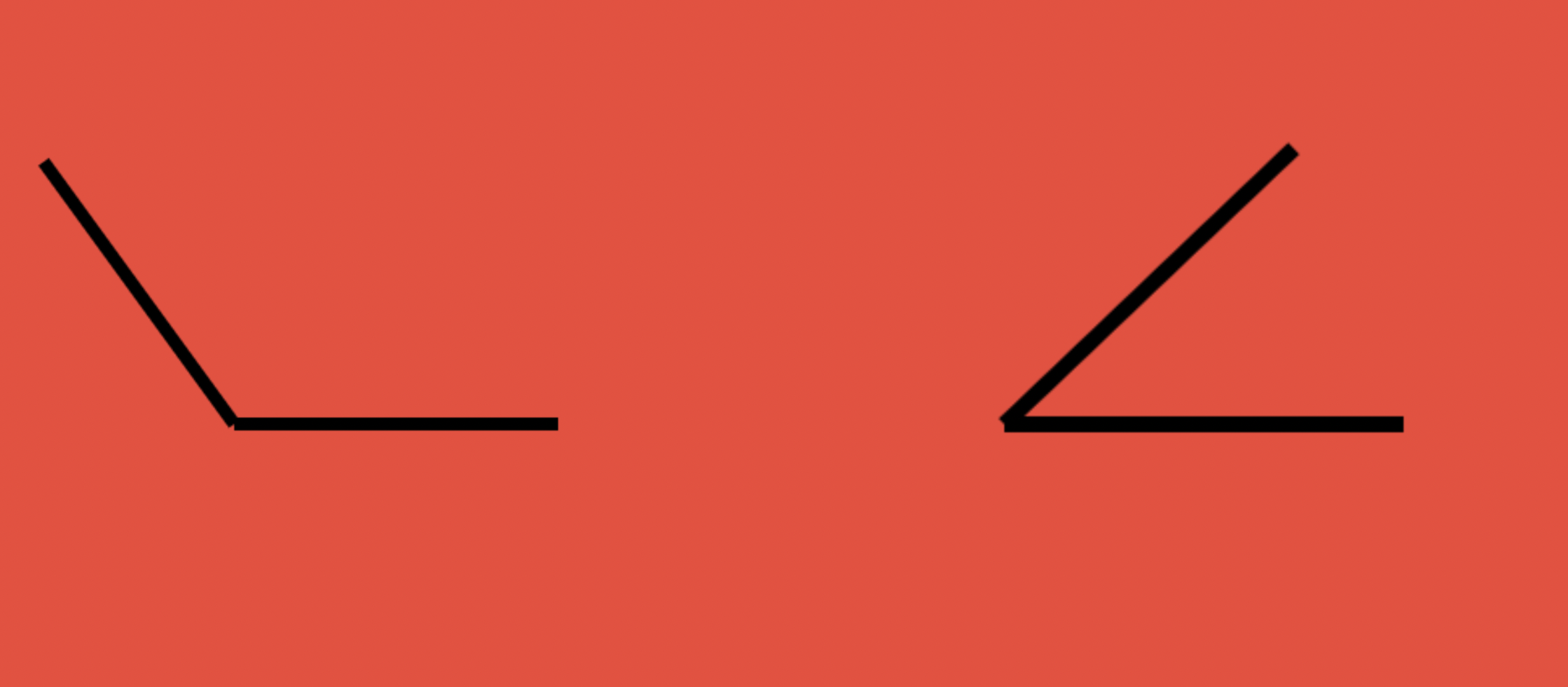
接下来 main 里面的代码,这部分代码主要就是:
- 归一化坐标为 0-1
- 根据行列数计算出每一「块粒子」该有的大小
- 计算出粒子的总数
- 在可移动角度里寻找“适合”移动的方向
vec2 uv=FlutterFragCoord().xy / uSize.xy;float particleWidth = 1.0 / particlesInRow;float particleHeight = 1.0 / particlesInColumn;float particlesCount = (1 / particleWidth) * (1 / particleHeight);for (float searchMovementAngle = min_movement_angle; searchMovementAngle <= max_movement_angle; searchMovementAngle += movement_angle_step){
可以看到,glsl 里的代码很多都是浮点计算,因为浮点计算其实是 GPU 的强项
calculateInitialParticleIndex 这个函数主要是将当前像素归集到某个「粒子块」里,因为每个「粒子块」都是有具体大小,所以一个「粒子块」都是由「一批像素」组成,也就是需要根据当前「粒子块」的 index 去确定像素属于哪一个「粒子块」。
int i = calculateInitialParticleIndex(uv, searchMovementAngle, animationValue, particleWidth, particleHeight);int calculateInitialParticleIndex(vec2 point, float angle, float animationValue, float particleWidth, float particleHeight){// x0 value is calculated from the following equation:// Given:// x = x0 + t * cos(angle) * particle_speed// t = animationValue - delay// delay = (1 - particle_lifetime) * x0// Getting the x0 from the equation:// t = animationValue - (1 - particle_lifetime) * x0// x = x0 + (animationValue - (1 - particle_lifetime) * x0) * cos(angle) * particle_speed// x = x0 + animationValue * cos(angle) * particle_speed - (1 - particle_lifetime) * x0 * cos(angle) * particle_speed// x = x0 - (1 - particle_lifetime) * x0 * cos(angle) * particle_speed + animationValue * cos(angle) * particle_speed// x = x0 * (1 - (1 - particle_lifetime) * cos(angle) * particle_speed) + animationValue * cos(angle) * particle_speed// x - animationValue * cos(angle) * particle_speed = x0 * (1 - (1 - particle_lifetime) * cos(angle) * particle_speed)// x0 = (x - animationValue * cos(angle) * particle_speed) / (1 - (1 - particle_lifetime) * cos(angle) * particle_speed)float x0 = (point.x - animationValue * cos(angle) * particleSpeed) / (1. - (1. - particleLifetime) * cos(angle) * particleSpeed);float delay = delayFromParticleCenterPos(x0);float y0 = point.y - (animationValue - delay) * sin(angle) * particleSpeed;.if (angle <= - pi / 2 && point.x >= x0){return (int(point.x / particleWidth) + int(point.y / particleHeight) * int(1 / particleWidth));}if (angle >= - pi / 2 && point.x < x0){return (int(point.x / particleWidth) + int(point.y / particleHeight) * int(1 / particleWidth));}return int(x0 / particleWidth) + int(y0 / particleHeight) * int(1 / particleWidth);}
另外这里是根据粒子移动的过的路径去反推出它原本的位置,从而再确定它原本属于哪个粒子块,因为在后续移动的时候,像素是:
- vec2 zeroPointPixelPos = vec2(uv.x - adjustedTime cos(angle) particleSpeed
- float adjustedTime = max(0.0, animationValue - delay);
- float delay = delayFromParticleCenterPos(particleCenterPos.x);
- delayFromParticleCenterPos = (1. - particleLifetime)*x;
所以进来的移动后的粒子像素,可以这个移动公式,如注释那样,反推出它原本的 x 和 y 位置,从而确定它最初的「粒子块 index」 。
另外这里做了 (angle <= - pi / 2 && point.x >= x0) 和 (angle >= - pi / 2 && point.x < x0) 的判断,也就是此时这些条件下,这些粒子本身属于并没有移动过,只需要按照原本计算其归属 index 就可以了。

如果没有上面两个 if 判断,那么在动画过程中就会是这样的效果,还没有移动的像素因为「归属块」不对,出现在了错误的位置:
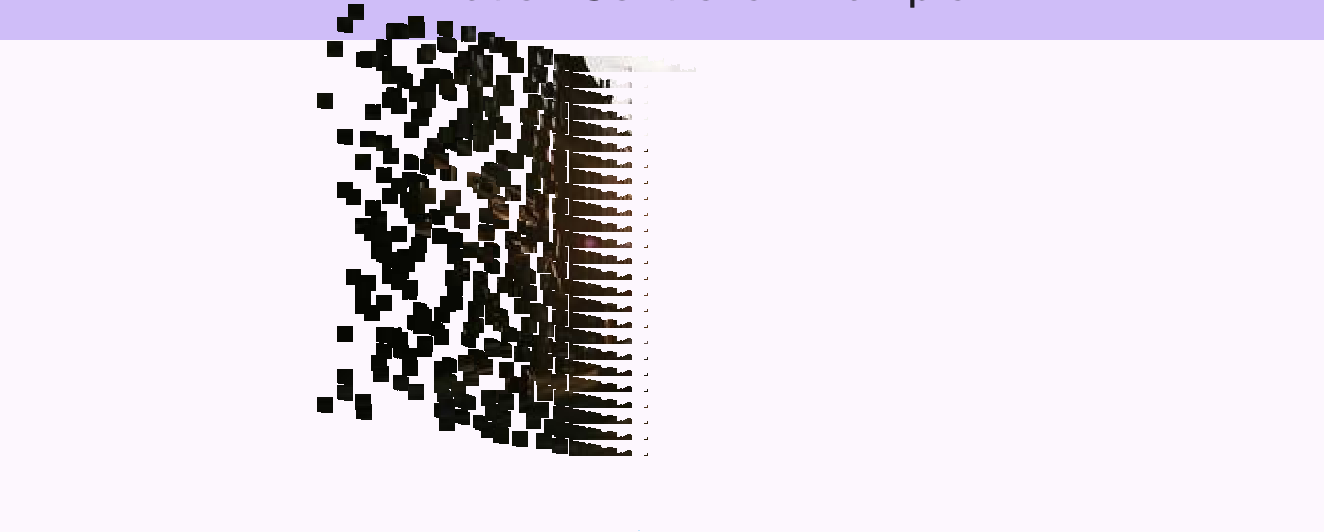
剩下的就是正常测粒子移动还有透明化的效果:
- randomAngle 其实就是一个伪随机实现,他主要和「粒子块」归属的 index 有关系,同一个块(i)的移动角度是一致的
- particleCenterPos 是计算出粒子块的中心位置
- delayFromParticleCenterPos 其实就是根据粒子的生命周期时间 particleLifetime 结合位置去计算一个延迟,简单说就是根据 animationValue 的数值,还没有粒子化的像素块不移动
- zeroPointPixelPos 就是根据角度移动后 x 和 y 的位置
- 接下来就是确定移动后的像素位于粒子块
- 如果不在粒子块内的,就透明处理 vec4(0.0, 0.0, 0.0, 0.0);
float angle = randomAngle(i);vec2 particleCenterPos = vec2(mod(float(i), 1 / particleWidth) * particleWidth + particleWidth / 2, int(float(i) / (1 / particleWidth)) * particleHeight + particleHeight / 2);float delay = delayFromParticleCenterPos(particleCenterPos.x);float adjustedTime = max(0.0, animationValue - delay);vec2 zeroPointPixelPos = vec2(uv.x - adjustedTime * cos(angle) * particleSpeed, uv.y - adjustedTime * sin(angle) * particleSpeed);if (zeroPointPixelPos.x >= particleCenterPos.x - particleWidth / 2 && zeroPointPixelPos.x <= particleCenterPos.x + particleWidth / 2 &&zeroPointPixelPos.y >= particleCenterPos.y - particleHeight / 2 && zeroPointPixelPos.y <= particleCenterPos.y + particleHeight / 2){vec4 zeroPointPixelColor = texture(uImageTexture, zeroPointPixelPos);float alpha = zeroPointPixelColor.a;float fadeOutLivetime = max(0.0, adjustedTime - (particleLifetime - fadeOutDuration));fragColor = zeroPointPixelColor * (1.0 - fadeOutLivetime / fadeOutDuration);return;}fragColor = vec4(0.0, 0.0, 0.0, 0.0);
可以看到粒子化后的效果其实挺酷炫的,最终效果是对指定的 UI 进行粒子化动画,并且通过 OverlayPortal 做到页面内图层区分渲染,整体性能比起在 Dart 实现效果确实优秀不少:

其实很多已有的 glsl 效果都可以移植到 Flutter ,例如 shadertoy 上的各种效果,举个例子,shadertoy 上经典的 water shader 就可以通过修改移植到 Flutter :
uniform vec2 iResolution;uniform float iTime;uniform float SEA_HEIGHT;vec2 iMouse = vec2(0);out vec4 fragColor;// Ported from https://www.shadertoy.com/view/Ms2SD1 to Flutterconst int NUM_STEPS = 8;const float PI = 3.141592;const float EPSILON = 1e-3;#define EPSILON_NRM (0.1 / iResolution.x)#define AA// seaconst int ITER_GEOMETRY = 3;const int ITER_FRAGMENT = 5;const float SEA_CHOPPY = 4.0;const float SEA_SPEED = 0.8;const float SEA_FREQ = 0.16;const vec3 SEA_BASE = vec3(0.0,0.09,0.18);const vec3 SEA_WATER_COLOR = vec3(0.8,0.9,0.6)*0.6;#define SEA_TIME (1.0 + iTime * SEA_SPEED)const mat2 octave_m = mat2(1.6,1.2,-1.2,1.6);// mathmat3 fromEuler(vec3 ang) {vec2 a1 = vec2(sin(ang.x),cos(ang.x));vec2 a2 = vec2(sin(ang.y),cos(ang.y));vec2 a3 = vec2(sin(ang.z),cos(ang.z));mat3 m;m[0] = vec3(a1.y*a3.y+a1.x*a2.x*a3.x,a1.y*a2.x*a3.x+a3.y*a1.x,-a2.y*a3.x);m[1] = vec3(-a2.y*a1.x,a1.y*a2.y,a2.x);m[2] = vec3(a3.y*a1.x*a2.x+a1.y*a3.x,a1.x*a3.x-a1.y*a3.y*a2.x,a2.y*a3.y);return m;}float hash( vec2 p ) {float h = dot(p,vec2(127.1,311.7));return fract(sin(h)*43758.5453123);}float noise( in vec2 p ) {vec2 i = floor( p );vec2 f = fract( p );vec2 u = f*f*(3.0-2.0*f);return -1.0+2.0*mix( mix( hash( i + vec2(0.0,0.0) ),hash( i + vec2(1.0,0.0) ), u.x),mix( hash( i + vec2(0.0,1.0) ),hash( i + vec2(1.0,1.0) ), u.x), u.y);}// lightingfloat diffuse(vec3 n,vec3 l,float p) {return pow(dot(n,l) * 0.4 + 0.6,p);}float specular(vec3 n,vec3 l,vec3 e,float s) {float nrm = (s + 8.0) / (PI * 8.0);return pow(max(dot(reflect(e,n),l),0.0),s) * nrm;}// skyvec3 getSkyColor(vec3 e) {e.y = (max(e.y,0.0)*0.8+0.2)*0.8;return vec3(pow(1.0-e.y,2.0), 1.0-e.y, 0.6+(1.0-e.y)*0.4) * 1.1;}// seafloat sea_octave(vec2 uv, float choppy) {uv += noise(uv);vec2 wv = 1.0-abs(sin(uv));vec2 swv = abs(cos(uv));wv = mix(wv,swv,wv);return pow(1.0-pow(wv.x * wv.y,0.65),choppy);}float map(vec3 p) {float freq = SEA_FREQ;float amp = SEA_HEIGHT;float choppy = SEA_CHOPPY;vec2 uv = p.xz; uv.x *= 0.75;float d, h = 0.0;for(int i = 0; i < ITER_GEOMETRY; i++) {d = sea_octave((uv+SEA_TIME)*freq,choppy);d += sea_octave((uv-SEA_TIME)*freq,choppy);h += d * amp;uv *= octave_m; freq *= 1.9; amp *= 0.22;choppy = mix(choppy,1.0,0.2);}return p.y - h;}float map_detailed(vec3 p) {float freq = SEA_FREQ;float amp = SEA_HEIGHT;float choppy = SEA_CHOPPY;vec2 uv = p.xz; uv.x *= 0.75;float d, h = 0.0;for(int i = 0; i < ITER_FRAGMENT; i++) {d = sea_octave((uv+SEA_TIME)*freq,choppy);d += sea_octave((uv-SEA_TIME)*freq,choppy);h += d * amp;uv *= octave_m; freq *= 1.9; amp *= 0.22;choppy = mix(choppy,1.0,0.2);}return p.y - h;}vec3 getSeaColor(vec3 p, vec3 n, vec3 l, vec3 eye, vec3 dist) {float fresnel = clamp(1.0 - dot(n,-eye), 0.0, 1.0);fresnel = pow(fresnel,3.0) * 0.5;vec3 reflected = getSkyColor(reflect(eye,n));vec3 refracted = SEA_BASE + diffuse(n,l,80.0) * SEA_WATER_COLOR * 0.12;vec3 color = mix(refracted,reflected,fresnel);float atten = max(1.0 - dot(dist,dist) * 0.001, 0.0);color += SEA_WATER_COLOR * (p.y - SEA_HEIGHT) * 0.18 * atten;color += vec3(specular(n,l,eye,60.0));return color;}// tracingvec3 getNormal(vec3 p, float eps) {vec3 n;n.y = map_detailed(p);n.x = map_detailed(vec3(p.x+eps,p.y,p.z)) - n.y;n.z = map_detailed(vec3(p.x,p.y,p.z+eps)) - n.y;n.y = eps;return normalize(n);}float heightMapTracing(vec3 ori, vec3 dir, out vec3 p) {float tm = 0.0;float tx = 1000.0;float hx = map(ori + dir * tx);if(hx > 0.0) {p = ori + dir * tx;return tx;}float hm = map(ori + dir * tm);float tmid = 0.0;for(int i = 0; i < NUM_STEPS; i++) {tmid = mix(tm,tx, hm/(hm-hx));p = ori + dir * tmid;float hmid = map(p);if(hmid < 0.0) {tx = tmid;hx = hmid;} else {tm = tmid;hm = hmid;}}return tmid;}vec3 getPixel(in vec2 coord, float time) {vec2 uv = coord / iResolution.xy;uv = uv * 2.0 - 1.0;uv.x *= iResolution.x / iResolution.y;// rayvec3 ang = vec3(sin(time*3.0)*0.1,sin(time)*0.2+0.3,time);vec3 ori = vec3(0.0,3.5,time*5.0);vec3 dir = normalize(vec3(uv.xy,-2.0)); dir.z += length(uv) * 0.14;dir = normalize(dir) * fromEuler(ang);// tracingvec3 p;heightMapTracing(ori,dir,p);vec3 dist = p - ori;vec3 n = getNormal(p, dot(dist,dist) * EPSILON_NRM);vec3 light = normalize(vec3(0.0,1.0,0.8));// colorreturn mix(getSkyColor(dir),getSeaColor(p,n,light,dir,dist),pow(smoothstep(0.0,-0.02,dir.y),0.2));}void main() {float time = iTime * 0.3 + iMouse.x*0.01;vec3 color = getPixel(gl_FragCoord.xy, time);// postfragColor = vec4(pow(color,vec3(0.65)), 1.0);}
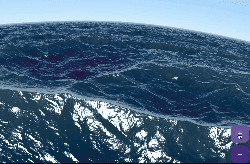
还有在之前介绍过用纯 Dart 实现了《霓虹灯文本的「故障」效果的实现》 如下所示是纯 dart 代码的实现:
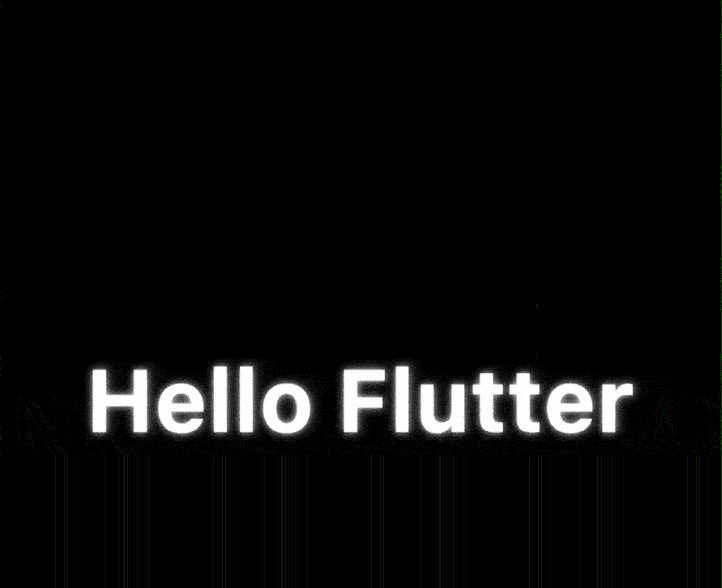
uniform vec2 iResolution;uniform float iTime;uniform sampler2D iChannel0;out vec4 fragColor;vec3 iMouse = vec3(0.0, 0.0, 0.0);// change these values to 0.0 to turn off individual effectsfloat vertJerkOpt = 1.0;float vertMovementOpt = 1.0;float bottomStaticOpt = 1.0;float scalinesOpt = 1.0;float rgbOffsetOpt = 1.0;float horzFuzzOpt = 1.0;// Noise generation functions borrowed from:// https://github.com/ashima/webgl-noise/blob/master/src/noise2D.glslvec3 mod289(vec3 x) {return x - floor(x * (1.0 / 289.0)) * 289.0;}vec2 mod289(vec2 x) {return x - floor(x * (1.0 / 289.0)) * 289.0;}vec3 permute(vec3 x) {return mod289(((x*34.0)+1.0)*x);}float snoise(vec2 v){const vec4 C = vec4(0.211324865405187, // (3.0-sqrt(3.0))/6.00.366025403784439, // 0.5*(sqrt(3.0)-1.0)-0.577350269189626, // -1.0 + 2.0 * C.x0.024390243902439); // 1.0 / 41.0// First cornervec2 i = floor(v + dot(v, C.yy) );vec2 x0 = v - i + dot(i, C.xx);// Other cornersvec2 i1;//i1.x = step( x0.y, x0.x ); // x0.x > x0.y ? 1.0 : 0.0//i1.y = 1.0 - i1.x;i1 = (x0.x > x0.y) ? vec2(1.0, 0.0) : vec2(0.0, 1.0);// x0 = x0 - 0.0 + 0.0 * C.xx ;// x1 = x0 - i1 + 1.0 * C.xx ;// x2 = x0 - 1.0 + 2.0 * C.xx ;vec4 x12 = x0.xyxy + C.xxzz;x12.xy -= i1;// Permutationsi = mod289(i); // Avoid truncation effects in permutationvec3 p = permute( permute( i.y + vec3(0.0, i1.y, 1.0 ))+ i.x + vec3(0.0, i1.x, 1.0 ));vec3 m = max(0.5 - vec3(dot(x0,x0), dot(x12.xy,x12.xy), dot(x12.zw,x12.zw)), 0.0);m = m*m ;m = m*m ;// Gradients: 41 points uniformly over a line, mapped onto a diamond.// The ring size 17*17 = 289 is close to a multiple of 41 (41*7 = 287)vec3 x = 2.0 * fract(p * C.www) - 1.0;vec3 h = abs(x) - 0.5;vec3 ox = floor(x + 0.5);vec3 a0 = x - ox;// Normalise gradients implicitly by scaling m// Approximation of: m *= inversesqrt( a0*a0 + h*h );m *= 1.79284291400159 - 0.85373472095314 * ( a0*a0 + h*h );// Compute final noise value at Pvec3 g;g.x = a0.x * x0.x + h.x * x0.y;g.yz = a0.yz * x12.xz + h.yz * x12.yw;return 130.0 * dot(m, g);}float staticV(vec2 uv) {float staticHeight = snoise(vec2(9.0,iTime*1.2+3.0))*0.3+5.0;float staticAmount = snoise(vec2(1.0,iTime*1.2-6.0))*0.1+0.3;float staticStrength = snoise(vec2(-9.75,iTime*0.6-3.0))*2.0+2.0;return (1.0-step(snoise(vec2(5.0*pow(iTime,2.0)+pow(uv.x*7.0,1.2),pow((mod(iTime,100.0)+100.0)*uv.y*0.3+3.0,staticHeight))),staticAmount))*staticStrength;}void main(){vec2 uv = gl_FragCoord.xy/iResolution.xy;float jerkOffset = (1.0-step(snoise(vec2(iTime*1.3,5.0)),0.8))*0.05;float fuzzOffset = snoise(vec2(iTime*15.0,uv.y*80.0))*0.003;float largeFuzzOffset = snoise(vec2(iTime*1.0,uv.y*25.0))*0.004;float vertMovementOn = (1.0-step(snoise(vec2(iTime*0.2,8.0)),0.4))*vertMovementOpt;float vertJerk = (1.0-step(snoise(vec2(iTime*1.5,5.0)),0.6))*vertJerkOpt;float vertJerk2 = (1.0-step(snoise(vec2(iTime*5.5,5.0)),0.2))*vertJerkOpt;float yOffset = abs(sin(iTime)*4.0)*vertMovementOn+vertJerk*vertJerk2*0.3;float y = mod(uv.y+yOffset,1.0);float xOffset = (fuzzOffset + largeFuzzOffset) * horzFuzzOpt;float staticVal = 0.0;for (float y = -1.0; y <= 1.0; y += 1.0) {float maxDist = 5.0/200.0;float dist = y/200.0;staticVal += staticV(vec2(uv.x,uv.y+dist))*(maxDist-abs(dist))*1.5;}staticVal *= bottomStaticOpt;float red = texture( iChannel0, vec2(uv.x + xOffset -0.01*rgbOffsetOpt,y)).r+staticVal;float green = texture( iChannel0, vec2(uv.x + xOffset, y)).g+staticVal;float blue = texture( iChannel0, vec2(uv.x + xOffset +0.01*rgbOffsetOpt,y)).b+staticVal;vec3 color = vec3(red,green,blue);float scanline = sin(uv.y*800.0)*0.04*scalinesOpt;color -= scanline;fragColor = vec4(color,1.0);}
其实可以移植另外的 gl 实现,修改为 webgl-noise 上的 glsl 效果,如下图所示,可以看到修改后的文本有了不一样的「故障」效果:
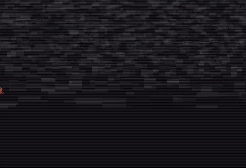
最后,现在通过 flutter_shaders 就可以在 Flutter 很方便的接入各种 glsl 代码效果,只需要配置对应的属性,控制变量参数即可,当然 thanos_snap_effect 粒子效果的有趣之处,在于他结合了截图和 OverlayPortal 封装出一个更有意思的实现,所以可以看出来,其实 shader 在 Flutter 上还是有着需要玩法,这样看,更期待后续 Flutter GPU 的落地了。
